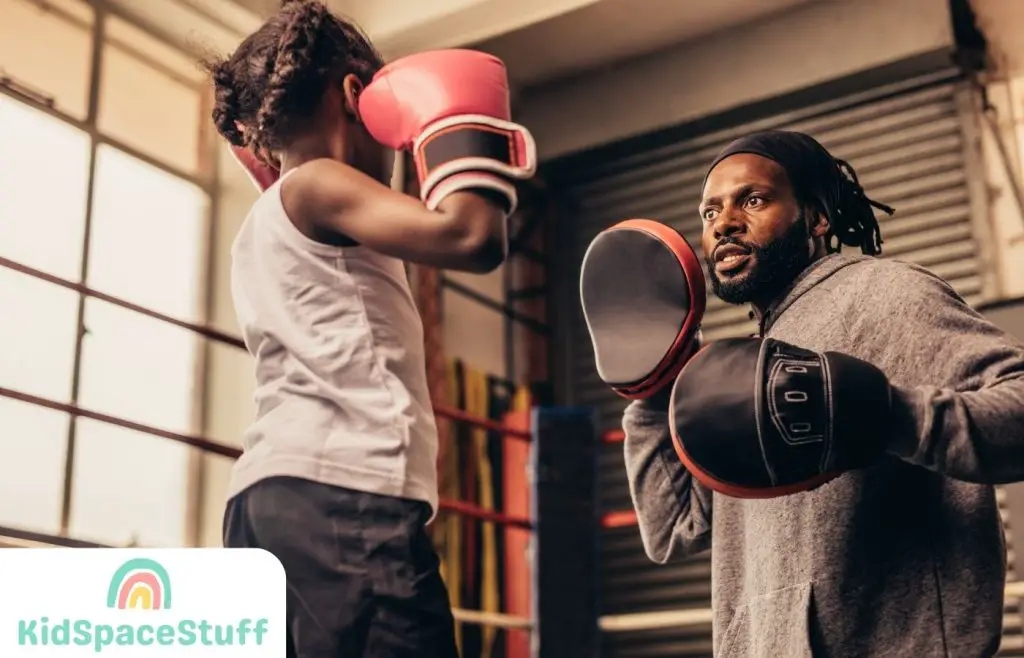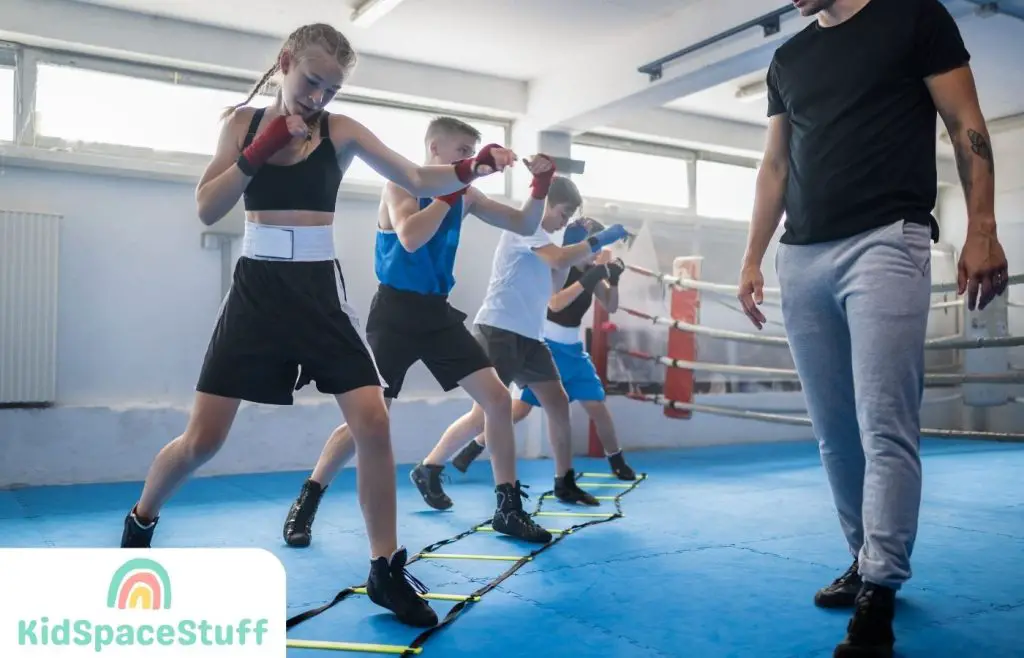Both the physical and mental health benefits boxing offers are incredible for people of any age. But what’s a good age for kids to begin boxing lessons?
In this article, I’ll uncover when it’s safe for kids to start training for any combat sport like boxing so you can make an informed decision for your child. Let’s dig in!
What Age Can Kids Start Boxing?

Generally, kids as young as 8 years old can start learning the basics of boxing, such as stance, footwork, and basic punches. At this age, they’re usually introduced to the sport without any sparring or contact. This helps them develop a foundation before they begin more advanced training.
As children enter their early teens, around 12 to 15 years old, they can start engaging in light sparring.
This age group is typically more equipped to handle the physical and mental demands of sparring, which is an essential aspect of boxing training. It’s crucial to remember that supervised and controlled sparring is necessary to ensure safety and proper learning.
There are even some world champions who didn’t start boxing until adulthood, so the best age to start boxing can vary depending on an individual’s skill and determination. However, for those looking to be highly competitive, getting an early start in the sport can be beneficial.
Training at a young age can have a positive impact on the development of discipline, self-esteem, and physical fitness among kids and adolescents. Regardless of the age group, it’s important to have qualified coaches and proper safety gear to minimize the risk of injuries.
The best age to start boxing depends on personal goals, individual capabilities, and available training resources, just like with gymnastics or any other sport. It’s never too early or too late to learn the sweet science of this fascinating and multi-dimensional sport.
Benefits of Boxing for Kids

Boxing can be a great way for kids to improve their overall fitness and develop various essential skills. When practiced correctly and safely, boxing offers numerous benefits to kids of all ages. Let us explore some of these advantages.
Firstly, boxing is an excellent way to improve physical fitness. The intense workouts that come with boxing help kids develop their cardiovascular endurance, muscle strength, and overall stamina. As we all know, staying active and healthy is crucial for kids, and boxing can be a fun and challenging way to achieve that.
Another great benefit of boxing for kids is the development of discipline. Learning boxing techniques and routines requires dedication, perseverance, and practice. Through boxing, kids can learn the value of hard work and the importance of setting and achieving goals.
In addition to discipline, boxing can boost kids’ confidence. As they progress and master new skills, they will develop a sense of accomplishment, which can translate to increased self-esteem. This newfound confidence can benefit them not just in sports but in other aspects of their lives as well.
Boxing also helps kids develop better coordination and balance. The sport requires them to perform various movements that engage different muscles and require good hand-eye coordination. As they improve their boxing skills, their overall coordination and balance will also improve.
Lastly, boxing is a great way for kids to build strength. The sport targets different muscle groups, including the arms, legs, and core muscles. Regular practice will lead to increased muscle tone and power, which can benefit their overall physical abilities.
Basic Training and Techniques
When it comes to teaching kids the basics of boxing, it’s important to start with the foundational techniques. We believe in focusing on proper footwork, correct fighting stances, and basic punches to build a solid foundation. Let’s dive into some of the most important aspects of boxing training for children.
Proper footwork helps young boxers maintain balance and stability when throwing punches. We emphasize teaching kids how to move swiftly and efficiently in the ring, ensuring they’re always in the right position to attack and defend. By incorporating simple boxing drills, like shuffling or stepping in different directions, kids can practice their footwork and develop in-ring agility.
Next, it’s crucial that we introduce the correct fighting stance. A balanced stance is key for maintaining control and stability during a match. We teach kids to stand with their feet shoulder-width apart while slightly bending their knees. This position enables optimal balance and allows the young boxers to effectively transfer their weight when throwing punches.
The basic punches, such as the jab, cross, hook, and uppercut, are the core techniques that every young boxer should learn. We provide detailed instructions on how to throw each punch correctly, focusing on proper form and technique. For instance, when teaching the jab, we stress the importance of extending the lead arm straight and quickly retracting it after making contact.
To further enhance our young boxers’ skills, we encourage them to participate in shadowboxing drills. Shadowboxing allows kids to practice their techniques without contact, enabling them to build muscle memory and work on their form. We also incorporate jumping rope into their training sessions since it’s a fantastic way to improve cardiovascular fitness, speed, and coordination.
Need more help? Check out the video below!
Safety Measures and Protective Gear
When it comes to boxing for kids, safety should always be our top priority. By taking necessary precautions and using the right protective gear, we can minimize the risk of head injuries, concussions, fractures, and other serious injuries.
First and foremost, we must ensure kids are using the appropriate gloves. Gloves provide adequate cushioning and help absorb the impact of punches, reducing the risk of injuries. It’s crucial to choose gloves that are specifically designed for children, as they need to fit properly and offer sufficient wrist support.
Besides gloves, other pieces of protective gear are essential to safeguard our kids from harm. Headgear is one of the most crucial elements, as it lessens the likelihood of head injuries and concussions. Look for headgears with ample padding and designs that fit comfortably and securely.
Mouthguards help protect young athletes’ teeth and jaws, while also reducing the chances of sustaining concussions. Ensure the mouthguard is made for the child’s mouth size and is comfortable to wear. Moreover, it’s worth investing in a high-quality mouthguard for enhanced protection.
For added safety, we can also make sure the kids wear padded clothing, such as chest protectors and groin guards, that protect them from potential harm to their bodies. These must effectively absorb shock and be comfortable for our kids.
Finally, we should emphasize the importance of a clean and well-maintained playing environment. The boxing ring or training area should be free from unnecessary objects that can become hazardous. It’s crucial to have appropriate flooring and padding to reduce the risk of falls and accidents.
Alternatives to Traditional Boxing
We understand that traditional boxing might not be suitable for everyone, especially for kids. That’s why we’ve put together a list of alternative martial arts styles for kids to explore. These options provide a fun, safe, and engaging way to introduce martial arts to children.
Kickboxing is a popular choice as it combines the elements of boxing with high-energy kicks. It’s a great way for kids to build strength, flexibility, and coordination while learning self-defense techniques. Plus, it’s an excellent cardiovascular workout that can keep them fit and active.
Mixed martial arts (MMA) is an exciting option for those looking to learn multiple disciplines. MMA combines various martial arts styles, such as Brazilian jiu-jitsu, Muay Thai, wrestling, and more. This allows kids to find a technique they enjoy and develop an individualized skill set. MMA classes often emphasize discipline, respect, and teamwork, helping kids build valuable life skills.
In addition to kickboxing and MMA, there are various other martial arts disciplines for kids to explore. Taekwondo, karate, and judo are just a few examples that focus on self-defense, discipline, and physical fitness. These arts can help children build confidence, athleticism, and a strong foundation for lifelong fitness.
Frequently Asked Questions
At what age is it suitable for children to begin learning boxing?
Most kids start boxing training around 8 to 10 years of age. Starting at this younger age allows children to develop good habits, improve motor skills, and begin building muscle memory. Boxing classes also provide a great exercise for physical health and can boost a child’s mental health through the discipline and focus required.
What’s the youngest a child can join a kids boxing class?
Some boxing gyms offer youth boxing classes for kids as young as 6 years old. These classes generally focus on the basics of boxing, promoting physical activity in a playful way, and teaching kids boxing skills without actual combat. It’s a fun, safe environment where children younger can learn boxing, often with kid-sized boxing gloves and punching bags.
Is there an ideal age to start boxing training for kids?
The optimal age to start boxing training can vary, but many coaches recommend around 8 to 10 years. This age allows for sufficient physical and mental development to grasp boxing fundamentals. Starting training at this young age can help children develop self-discipline, self-control, and the muscle strength necessary for boxing.
What are the boxing age categories for children’s competitions?
Children’s boxing competitions typically start for junior boxers at age 8. The age groups usually go in two-year increments (8-9, 10-11, 12-13, etc.). It’s important to note that safety measures, including protective equipment and light sparring rules, are typically enforced in these youth boxing matches to ensure the well-being of the young participants.
Final Thoughts
Boxing is a remarkable sport that offers physical and mental health benefits, including increased motor skills, self-discipline, and self-control.
With boxing training available for kids as young as 6, it provides a unique opportunity for personal development from a young age.
Remember, the optimal age for most kids to start boxing lessons varies, typically between 8 to 10 years. Always ensure safety with protective equipment and suitable training techniques as your child embarks on their boxing journey.
KidSpaceStuff is a site dedicated to helping parents find the best interior design, activities, and inspiration for their kids.